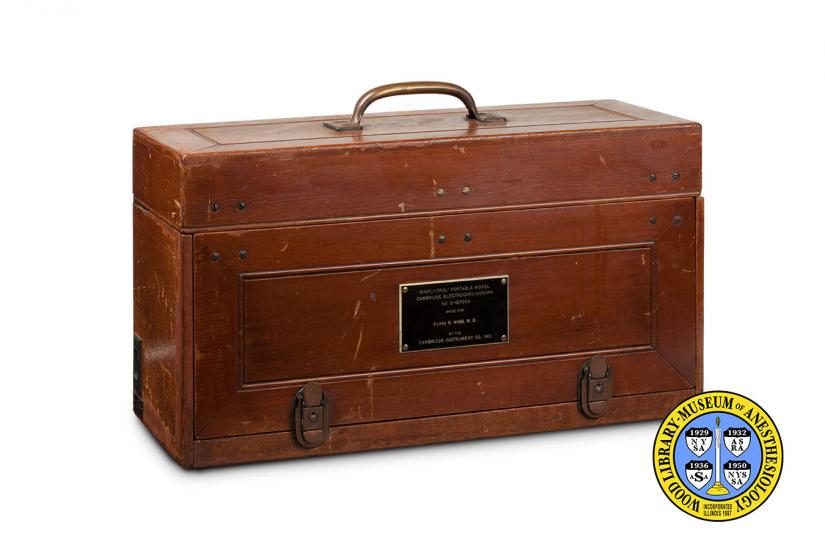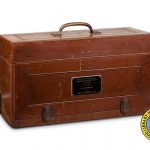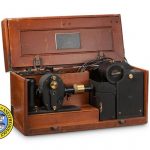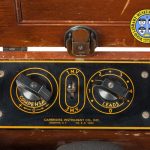Cambridge Simpli-Trol EKG
Anesthesiologists are responsible for maintaining the patient's vital functions during surgery, including monitoring of the heart and, when necessary, performing cardiac resuscitation. The abbreviations ECG and EKG are used interchangeably to mean both "electrocardiograph" and "electrocardiogram". An electrocardiograph is an instrument that displays, and records, a graphic representation of the heart's electrical activity. An electrocardiogram is the graphic tracing of that activity.
Since the Italian physicist Dr. Luigi Galvani (1737-1798) first proposed the idea of "animal electricity" in 1787, the work of many scientists has led to development of the electrocardiographs used today. The first machine that could produce a paper record of electrical currents was invented in 1867. The first human electrocardiogram was published twenty years later. In 1901, the Dutch physiologist Dr. Willem Einthoven (1860-1927) invented the string galvanometer. It was commercially manufactured by the Cambridge Scientific Instrument Company around 1911. The company made many subsequent models, including the Simpli-Trol Portable Model, produced from the 1930s to the 1950s. In addition to recording the heart's electrical activity (electrocardiograms), this instrument could also record the pulse and heart sounds.
Catalog Record: Cambridge Simpli-Trol EKG
Access Key: akup
Accession No.: 1989-09-03-2
Title: Cambridge electrocardiograph : “Simpli-Trol” portable model / Cambridge
Instrument Co. Inc.
Corporate Author: Cambridge Instrument Company.
Title variation: Alt Title
Title: Cambridge electrocardiograph : Simpltrol portable model.
Publisher: Ossining, N.Y. : Cambridge Instrument Co., Inc., [between 1930 and 1950].
Physical Descript: 1 electrocardiograph : wood, metals, plastics, glass, rubber ; 32.5 x 49.5 x 21 cm.
Subject: Electrocardiography – instrumentation.
Subject: Monitoring, Intraoperative.
Subject: Monitoring, Physiologic – instrumentation.
Note Type: Citation
Notes: The early year in the date range for the possible year of manufacture of this
Simpli-Trol is based on its condition, the dates of publications in which the
Simpli-Trol is advertised, on the dates given to similar devices cataloged in
other archives and museums, and on the dates of the professional career of
the physician who originally purchased it (Elihu S. Wing). The date range
could change if documentation that indicates the dates should be corrected is
discovered.
Note Type: Citation
Notes: Bause GS. An historical backdrop to cardiovascular monitoring. Anesthesiol
Clin North America. 1988;6(4):655-681.
Note Type: Citation
Notes: Cambridge “Simpli-Trol” Model Portable
Electrocardiograph-Stethograph:Condensed Operating Instructions. [Ossining, N
Y.: Cambridge Instrument Co. Inc.]; [undated].
Note Type: Citation
Notes: Rivera-Ruiz M, Cajavilca C, Varon J. Einthoven’s string galvanometer: the
first electrocardiograph. Tex Heart Inst J. 2008;35(2):174–178. https://www.
ncbi.nlm.nih.gov/pmc/articles/PMC2435435/. Accessed October 6, 2014.
Note Type: Citation
Notes: Westhorpe RN, Ball C. The electrocardiogram. Anaesth Intensive Care.
2010;38(2):231.
Note Type: Physical Description
Notes: An electrocardiograph in a wooden carrying case; This is a string
galvanometer type electrocardiograph; The case has a metal handle on top, and
two latches on the lower front side of the case. The top is hinged to the
back side of the case, and the top and front side are hinged together; On the
underside of the top is a small storage compartment; A plate on the front is
marked with the following: ‘”SIMPL-TROL” PORTABLE MODEL [new line] CAMBRIDGE
ELECTROCARDIOGRAPH [new line] NO. 0-167006 [new line] MADE FOR [new line]
ELIHU S. WING, M.D. [new line] BY THE [new line] CAMBRIDGE INSTRUMENT CO.
INC.’; An electric plug is located on the left exterior side of the case;
The electrical cord is missing from this unit; Inside, mounted in black metal
are the string galvonomether, the recording camera, and mount for recording
paper; Behind these on the left, mounted in wood, are two control dials; The
dial on the left is marked with, “0”; To the left of the zero is a positive
sign, and to the right of the zero is a negative sign; Between the two dials
is a two way switch; Marked above the switch is “1.M.V.”, and marked below
the switch is, “3.M.V.”; The dial on the right is marked, “LEADS” and has
five positions: 0, 1, 2, 3, and 4; To the right of the dials are two open
wooden partitions, which currently hold the large and small diameter cords
for the leads; A rubber or plastic covered cord extends from the right most
wooden partition, and ends in a wide port for the four smaller diameter lead
cords; Each port is marked for the corresponding lead, “RA”, “LL”, “P”, “LA”;
These are for the right arm, left leg, pulse, and left arm; Each lead cord
ends in a color-indicated electrode: RA is red, LL is tan, P is brown, and LA
is black; The length of the cord with leads is approximately 167 cm; On a
metal plate located in the right most wooden partition are manufacturer
markings, which include, “CAMBRIDGE INSTRUMENT CO., INC. [new line]OSSINING,
N.Y. NO. B. M. 12090 [new line] MANUFACTURED UNDER ONE OR MORE OF THE
FOLLOWING UNITED STATES PATENTS [new line] 1,702,650, 1,791,207, 1,797,237
[new line] 1,882,402, 1,840,834, 2,098,938.
Note Type: Reproduction
Notes: Photographed by Mr. Steve Donisch, September 17, 2013.
Note Type: Historical
Notes: An electrocardiograph is an instrument that detects and records the small
electrical changes that occur in the heart to produce the heartbeat.
Electrocardiographs are just one of the pieces of equipment used by
anesthesiologists to carefully monitor and care for the patient through all
stages of anesthesia and surgery.
The electrocardiograph described here is an example of one of the first
electrocardiographs that was light and compact enough to be carried by one
person. Made by the Cambridge Instrument Company of Ossining, N.Y., and
called the “Simpli-Trol” Portable Model, it was purchased by internal
medicine physician Elihu S. Wing (1884-1968), of Providence, Rhode Island. Dr
Wing not only used it in his office for clinical assessment and diagnosis,
he also used it to obtain electrocardiograms (the graphic image) of patients
during anesthesia and surgery. This was not at all common because
electrocardiographs posed a high risk of igniting the flammable anesthetics
that were used into the 1950s.
The Simpli-Trol employed the same primary technology that was introduced in
1901 by the Dutch physician and physiologists Willem Einthoven (1860-1927):
the string galvanometer. The Einthoven galvanometer employed a very fine
quartz string, which was coated in silver and vertically suspended between
the two poles of a magnet. When a minute electrical current passed through
the sting it produced a movement that was amplified with lenses and recorded
photographically.
Dr. Einthoven combined his string galvanometer with other equipment to
produce the first electrocardiograph, which he described in 1903. His
prototype occupied two rooms and took five people to operate. Einthoven’s
creation was carried forward by many scientists and manufacturing companies.
Models that could be rolled to a patient’s bedside became available during
the 1920s, and models that could be carried by one person soon followed.
Because of this and other ground breaking work, Dr. Einthoven is considered
the founder of modern cardiography, and was awarded the Nobel Prize in
physiology and medicine in 1924.
Note Type: Publication
Notes: Barold SS. Willem Einthoven and the birth of clinical electrocardiography a
hundred years ago. Card Electrophysiol Rev. 2003;7(1):99-104.
Note Type: Publication
Notes: Cajavilca C, Varon J. Resuscitation great. Willem Einthoven: the development
of the human electrocardiogram. Resuscitation. 2008;76(3):325-328.
Note Type: Exhibition
Notes: Exhibited in the Park Ridge, Northwest Highway, gallery from 1999-2003;
Selected for the WLM website.




